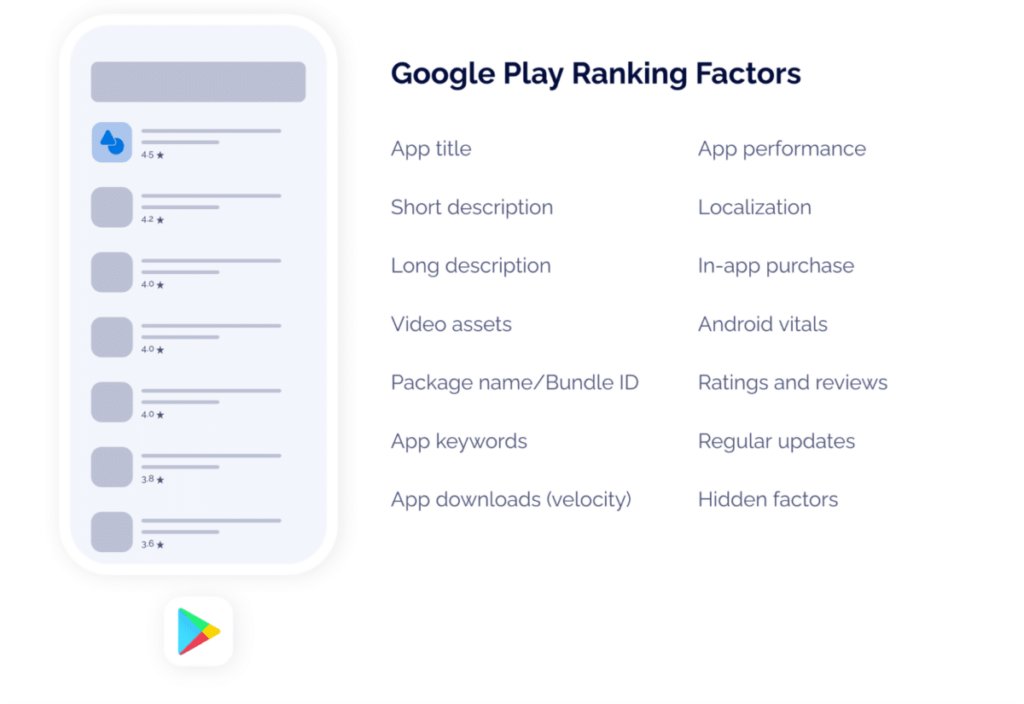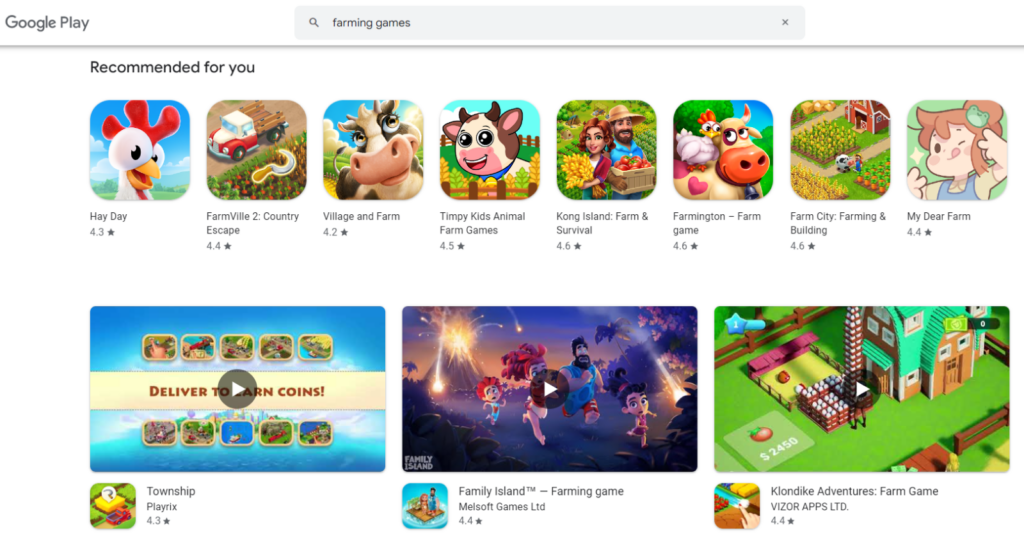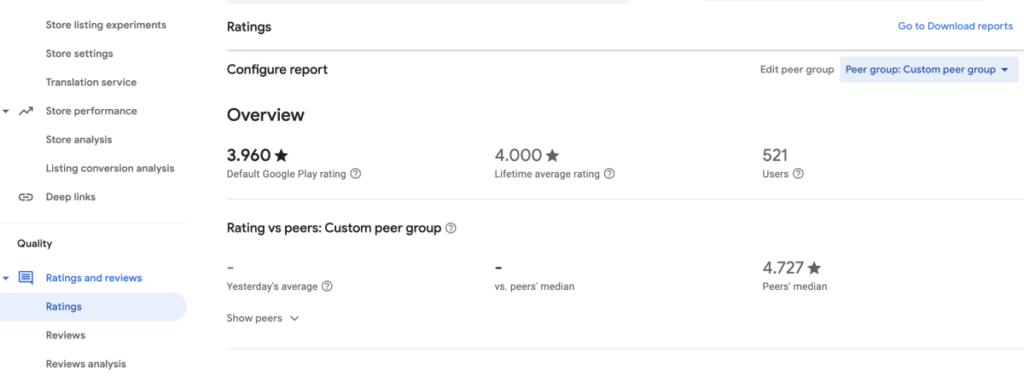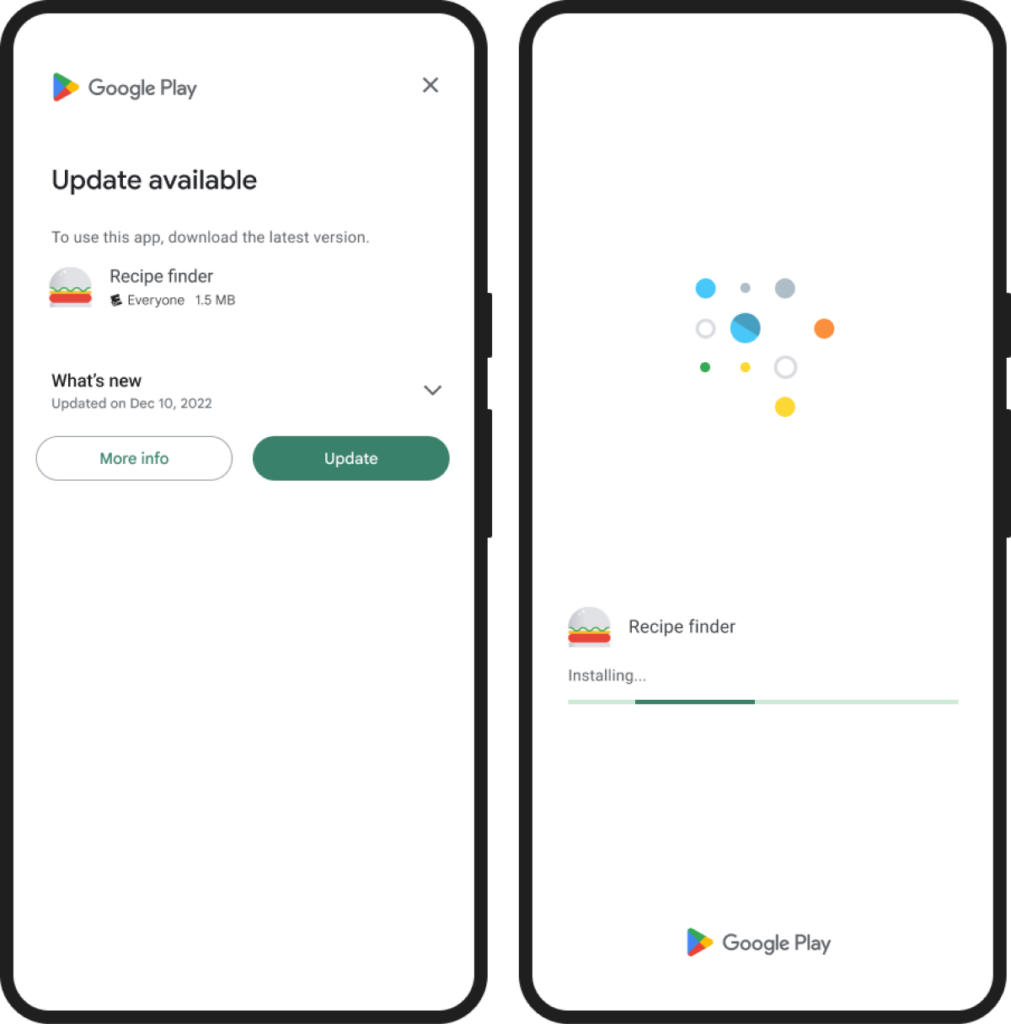The Google Play Store is a major digital marketplace with over 3 million apps, making it the primary destination for users seeking their next must-have mobile app. However, securing a prime spot in this highly competitive environment is quite challenging. App developers and marketers must understand the intricacies of the Google Play Store ranking algorithm because the success of their mobile app hinges directly on it.
According to Statista, organic search is the undisputed winner in app discovery, accounting for 69% of non-gaming app installs and an even more remarkable 88% for gaming apps. These statistics paint a clear and compelling picture: a high ranking within the Google Play Store directly leads to increased app visibility and, ultimately, user acquisition.
This article delves into the key factors that influence your app’s ranking within the Google Play Store. We’ll cover different topics, such as ways to improve app store visibility, methods for engaging users, and techniques for enhancing performance. By the end, you’ll have the knowledge to navigate complex ranking algorithms and propel your app for long-term growth. Let’s embark on this journey together and unleash the full potential of your app!
Understanding the Google Play Ranking Algorithm
On the whole, the Google Play Store ranking algorithm is designed to provide users with the best possible experience by presenting them with high-quality apps that are relevant to their needs. While the exact formula remains undisclosed, it’s well known that Google Play’s ranking algorithm takes into account a combination of direct and indirect factors.At first glance, direct factors like app title, description, and category selection play a crucial role, acting as signposts for the algorithm to understand the app’s purpose and target audience. These elements, along with the number of downloads and download velocity, directly influence ranking.
However, the algorithm digs deeper, analyzing indirect factors that paint a broader picture of user experience and app quality. User engagement metrics, like session duration and retention rate, along with app ratings and reviews, provide valuable insights into how users interact with the app. Addressing crashes, bugs, and ensuring smooth performance across devices further contribute to a positive user experience, which the algorithm rewards with better ranking.
It’s important to note that the exact weighting of each factor is unknown and may vary depending on the context, such as search queries, user location, and device type. Nevertheless, by focusing on both direct and indirect factors, developers can increase their chances of achieving higher visibility and attracting more users to the Google Play Store.
Top Google Play Store Ranking Factors
It’s no secret that getting your app ranked higher on the Google Play Store can have a significant impact on its success. But what exact factors does Google use to determine this ranking?

Let’s take a closer look at the most significant ranking elements and how app developers can leverage them to boost their app visibility!
App Title & Description
- App title
When it comes to Play Store rankings, the title is one of the most crucial factors. Ensure that the app title contains your relevant keywords and that these keywords complement your brand identity. Since you may only use 30 characters, be sure to carefully consider which keywords to add. While adding keywords at the start of the app title can enhance their importance, you still need to ensure that your brand name is immediately visible and adheres to Google Play policies.
- Short description
The second most essential ranking component is the short description, which also increases the app’s chances of ranking for specific keywords. You may use up to 80 characters to provide users with more information about your app. It may be tempting to stuff this area with keywords, so we advise you to consider your audience before matching your message with those that are relevant to your app.
- Long description
The long description has a limit of 4.000 characters that you may use to describe how your app works, specifics about its features, and more. Even though the majority of people who view your store listing won’t read the long description, Google Play will index the keywords in it. For this reason, it’s needed to include the most vital data in the first five phrases before the “show more” button. Although there are no set guidelines for keyword density, we advise you to repeat your best-performing keywords periodically throughout the content.
Overall, an app’s title and description should accurately reflect its content, as keywords rank higher in search results. These are also necessary to assist users in finding apps that correlate with their interests.
Targeted Keywords
Keywords serve as the cornerstone for app discovery in the Google Play Store. It is crucial to incorporate relevant search terms within your app’s ID, developer name, title, and short and long descriptions because they act like hints for both users and the ranking algorithm system. Finding the ideal balance is paramount. Adhering to character limits and guaranteeing brand alignment are just as important as integrating high-volume keywords. Keep in mind that keywords help the algorithm determine the goal of your app and who your ideal audience is, which helps it send the correct users to your project. Carefully choosing particular keywords relating to an app’s content increases its chances of showing in relevant search results, hence increasing its total exposure in the store’s ranks.
If you want to learn more about how to work with keywords effectively, we recommend reading our full article on this topic.
Relevant App Store Categories
Finding the perfect category for your app goes beyond simple organization. It’s a strategic decision that directly affects both user discoverability and potential ranking success. This is because the algorithm considers various factors, including download volume when determining ranking within each category. While a high number of downloads might significantly boost your ranking in a less competitive category, the same number might not have the same impact on a highly saturated one. Therefore, selecting the most relevant category, keeping competition in mind, is crucial for maximizing your app’s potential to climb the charts and reach its target audience effectively.
Number of Downloads
The total amount of downloads the app gets is a key indicator to Google Play that it is user-relevant. Due to the fact users often choose apps with a bigger download count, it thus directly affects visibility within the Google Play Store. In addition, download velocity and downloading-attracting keywords are also significant aspects. The more you focus on keyword optimization, the more likely you are to attract downloads for keywords, which improves your app store performance. Developers can boost this number by leveraging advertising campaigns (for example, keyword promotion) or motivating potential users through promotions and discounts. To find out all the advantages of keyword promotion, we recommend watching our video.
App Performance
App performance directly impacts user experience, a key factor that Google prioritizes in its ranking algorithms. Metrics, such as crash rates, app launch time, and responsiveness, play a crucial role in shaping users’ perception of your app. A poorly performing app with frequent crashes and lags will frustrate users, leading to negative reviews, uninstallations, and ultimately, lower rankings. Conversely, a well-optimized app that delivers a smooth experience encourages users to engage more, spending more time within the app and participating in activities that further improve your ranking. This positive feedback loop emphasizes the importance of prioritizing app performance throughout the development and maintenance process.
Ensuring an app performs well across different platforms and devices will provide users with an overall satisfying experience and encourage repeat visits, positively contributing to its ranking within the store’s listings or suggested content feeds.
Ratings & Reviews
- User ratings
Ratings are an important ASO aspect that you cannot directly influence. In any case, user experience and app quality have huge effects on how people perceive your app. They are more inclined to award your app with a good app rating if they had a great experience. The quantity and quality of your ratings are what counts most on Google Play. The ratings your app receives are displayed in search results and have an extensive impact on the install conversion rate. Furthermore, user ratings help your app get featured and demonstrate its superiority, which is why you should work constantly on gathering positive user ratings.
- User reviews
Reviews represent primarily the quality of the product, according to user opinion. Since a lot of people will want to evaluate your app and provide feedback, they frequently combine ratings and reviews. Positive comments from happy users will be indexed by the ranking system, which also takes into account the keywords they choose to describe their experience with the app. Although you can’t control what others write, you should always respond to negative feedback and resolve user issues. Unsatisfied individuals could change their ratings and reviews if they consider you helped them solve their situation.
Overall, user ratings and reviews are a crucial aspect of app development, as they can greatly impact the success and reputation of your app in the marketplace. It is important to actively engage with users and continuously improve your app based on their feedback to ensure a positive user experience and higher ratings.
Localization
While Google hasn’t explicitly confirmed localization as a main ranking factor, its impact on conversion rates is undeniable. Local users are more likely to install a localized app since they want to see the apps in their native language. This translates into a higher likelihood of them installing and engaging with the app. By localizing your store listing, you cater to a wider audience, remove language barriers, and create a more user-friendly experience, ultimately leading to increased conversions.
Focus on localization can also indirectly benefit your ranking. Google prioritizes apps that provide positive user experiences, and it views high conversion rates as a sign of user satisfaction. Additionally, localized apps often perform better in local search results, increasing their visibility and potentially attracting more organic downloads. As a result, localizing your store listings boosts conversion rates and can assist Google Play by offering localized apps an advantage over non-localized ones.
Regular Updates & Android Vitals
Regular updates and a focus on Android Vitals are crucial aspects of maintaining a healthy app that thrives in the Google Play Store. Think of Android Vitals as a set of checkpoints that Google uses to assess the technical performance and user experience of your app. These checkpoints encompass various metrics, with some of the most critical ones being ANR (App Not Responding) rates and app crashes.
Why are these factors important?
Exceeding negative thresholds in these areas can directly impact your app’s keyword ranking and visibility. This is because Google prioritizes apps that deliver a smooth experience for users. A poorly performing app with frequent crashes or ANRs creates frustration and discourages users from engaging with it. Remember, a well-maintained app not only benefits your users but also strengthens your app’s overall standing within the competitive landscape of the Play Store.
Strategies for Improving Your App’s Ranking in the Google Play Store
To rank higher in Google Play, knowing what matters is just the first step. Next, you need to develop an ASO plan that guides your efforts and consistently focuses on improving your store listings.
As we’ve already indicated, keywords play a big role in app store rankings. For this purpose, you should start thinking about the keyword optimization process. Various ASO specialists recommend organizing your keyword strategy into four primary categories:
- Conduct keyword research utilizing tools, your team, or industry experts.
- Sort and rank keywords according to their popularity, competitiveness, and relevancy.
- Choose the location and strategy for focusing on those keywords.
- Evaluate the influence of your work and monitor the outcomes and consequences.
To maximize effectiveness, integrate your keyword approach with other strategies, like raising your conversion rate. To attract new users and boost conversions, your Google Play app’s icon, images, and promotional video are crucial. You should try out several graphic elements and maintain the ones that are most interesting to users.
User management may be an integral part of your daily ASO activities. Make sure you spend some of your resources on customer support and experience improvement in communication with your app’s users.
Since lots of apps have a global user base, you should think about localizing your store listings and whether seasonality influences your app installs. The more relevant your app is to your target audience, the more likely you are to have greater conversion rates and climb the ratings.
If you have a high-quality app with a lot of favorable user reviews, you have a good chance of getting featured, which might affect your traffic and ranking. Just keep in mind that ASO demands ongoing efforts, so if you want to get into the Play Store, you have to work on it constantly.
In summary, navigating the Google Play Store algorithm and getting top position needs a diverse strategy. Meanwhile, you may greatly increase your app’s visibility and ultimately make it successful if you understand the key factors covered in this article. Remember, as well that the Play Store is always changing, so being up to date on the newest trends and best practices is essential for long-term success. Accept these helpful insights, keep improving your tactics, and watch your app rise through the ranks to realize its full potential in the constantly growing mobile app market.


























